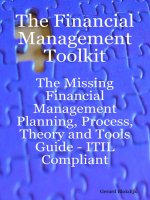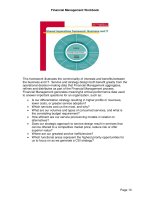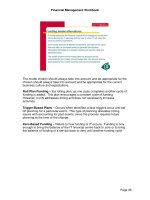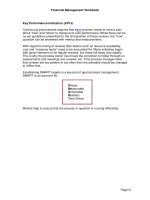The financial management toolkit the missing financial management planning process theory and tools guide
Bạn đang xem bản rút gọn của tài liệu. Xem và tải ngay bản đầy đủ của tài liệu tại đây (1.01 MB, 122 trang )
The Financial Management Toolkit:
The Missing Financial Management Planning, Process,
Theory and Tools Guide - ITIL Compliant
Notice of Rights: Copyright © The Art Of Service. All rights reserved. No part of
this book may be reproduced or transmitted in any form by any means,
electronic, mechanical, photocopying, recording, or otherwise, without the prior
written permission of the publisher.
Notice of Liability: The information in this book is distributed on an “As Is” basis
without warranty. While every precaution has been taken in the preparation of the
book, neither the author nor the publisher shall have any liability to any person or
entity with respect to any loss or damage caused or alleged to be caused directly
or indirectly by the instructions contained in this book or by the products
described in it.
Trademarks: Many of the designations used by manufacturers and sellers to
distinguish their products are claimed as trademarks. Where those designations
appear in this book, and the publisher was aware of a trademark claim, the
designations appear as requested by the owner of the trademark. All other
product names and services identified throughout this book are used in editorial
fashion only and for the benefit of such companies with no intention of
infringement of the trademark. No such use, or the use of any trade name, is
intended to convey endorsement or other affiliation with this book.
ITIL® is a Registered Community Trade Mark of OGC (Office of Government
Commerce, London, UK), and is Registered in the U.S. Patent and Trademark
Office.
Write a Review and Receive a Bonus Emereo
eBook of Your Choice
Up to $99 RRP – Absolutely Free
If you recently bought this book we would love to hear from you – submit
a review of this title and you’ll receive an additional free ebook of your
choice from our catalog at .
How Does it Work?
Submit your review of this title via the online store where you purchased
it. For example, to post a review on Amazon, just log in to your account
and click on the ‘Create Your Own Review’ button (under ‘Customer
Reviews’) on the relevant product page (you’ll find plenty of example
product reviews on Amazon). If you purchased from a different online
store, simply follow their procedures.
What Happens When I Submit my Review?
Once you have submitted your review, send us an email via
, and include a link to your review and a link to the
free eBook you’d like as our thank-you (from –
choose any book you like from the catalog, up to $99 RRP). You will then
receive a reply email back from us, complete with your bonus ebook
download link. It's that simple!
Financial Management Workbook
Table of Contents
1
INTRODUCTION ROADMAP....................................................................................................................... 5
2
FINANCIAL MANAGEMENT ....................................................................................................................... 9
3
SUPPORTING DOCUMENTS.................................................................................................................... 47
3.1
3.2
3.3
3.4
3.5
3.6
3.7
3.8
3.9
3.10
3.11
3.12
3.13
3.14
3.15
3.16
OBJECTIVES AND GOALS .............................................................................................................................. 49
POLICIES, OBJECTIVES & SCOPE ................................................................................................................ 53
COMMUNICATION PLAN ................................................................................................................................. 57
FINANCIAL MANAGEMENT PROCESS MANAGER ......................................................................................... 63
BUSINESS JUSTIFICATION DOCUMENT ......................................................................................................... 67
ACCOUNTING POLICIES ................................................................................................................................. 73
BUDGETING GUIDELINES............................................................................................................................... 77
CHARGING POLICIES ..................................................................................................................................... 83
REPORTS, KPIS AND OTHER METRICS ........................................................................................................ 89
SAMPLE BUSINESS CASE STRUCTURE ...................................................................................................... 97
COMMON BUSINESS OBJECTIVES .............................................................................................................. 99
EXAMPLE – SINGLE BUSINESS IMPACT CAN AFFECT MULTIPLE BUSINESS OBJECTIVES ................... 101
EXAMPLE – MULTIPLE BUSINESS IMPACT CAN AFFECT SINGLE BUSINESS OBJECTIVES ................... 103
EXAMPLE NPV DECISIONS ....................................................................................................................... 105
EXAMPLE: MODEL CALCULATION OF A SERVICE MANAGEMENT ROI .................................................. 107
EXAMPLE TREND LINE ANALYSIS ............................................................................................................ 109
4
IMPLEMENTATION PLAN ....................................................................................................................... 111
5
FURTHER READING ................................................................................................................................ 121
Page 3
Also from Emereo Publishing and The Art of Service:
IT Service Operations Management Guide:
Your Complete Guide to Managing an IT Service Operation
A professional technical roadmap to ITIL V3 Framework IT Service Operations
Management (Incident, Event, Problem and Access Management, plus Request
Fulfilment) with 34 templates and design documents for organizational
assessment and implementation.
Financial Management Workbook
1
INTRODUCTION ROADMAP
Many organizations are looking to implement Financial Management as a way to improve the
structure and quality of the business.
This document describes the contents of the Financial Management Workbook. The
information found within the book is based on the ITIL Version 3 framework, specifically the
Service Strategy phase which incorporates the updated ITIL Version 3 Financial Management
process.
The Workbook is designed to answer a lot of the questions that Financial Management process
raises and provides you with useful guides, templates and essential, but simple assessments.
The supporting documents and assessments will help you identify the areas within your
organization that require the most activity in terms of change and improvement.
Presentations can be used to educate or be used as the basis for management presentations
or when making business cases for Financial Management implementation.
The additional information and bonus resources will enable you to improve your organizations
methodology knowledge base.
The Workbook serves to act as a starting point. It will give you a clear path to travel. It is
designed to be a valuable source of information and activities.
The Financial Management Workbook:
Flows logically,
Is scalable,
Provides presentations, templates and documents,
Saves you time.
Page 5
Financial Management Workbook
Step 1
Start by reviewing the PowerPoint presentation:
1 Financial Management
The presentation provides a detailed and comprehensive overview of Financial
Management in the specialist areas of ITIL Version3
These presentations will give you a good knowledge and understanding of all the
terms, activities and concepts required within the Financial Management process.
They can also be used as the basis for management presentations or when making
a formal business case for Financial Management implementation. Make sure you
pay close attention to the notes pages, as well as the slides, as references to further
documents and resources are highlighted here.
Page 6
Financial Management Workbook
Step 2
If you did not look at the supporting documents and resources when prompted
during the PowerPoint presentations, do this now.
Below is an itemized list of the supporting documents and resources for easy
reference. You can use these documents and resources within your own
organization or as a template to help you in prepare your own bespoke
documentation.
Objectives and Goals
Policies, Objectives and Scope
Communication Plan
Financial Management Process Manager
Business Justification Document
Accounting Policies
Budgeting Guidelines
Charging Policies
Reports, KPIs and other Metrics
Sample Business Case Structure
Common business objectives
Example - Single business impact can affect multiple business
objectives
Example - Multiple business impacts can affect single business
objectives
Example NPV Decisions
Example Model: Calculation of a service management ROI
Example Trend Line Analysis
Page 7
Financial Management Workbook
Step 2 continued...
Alternatively, continue by working through the Financial Management
Implementation & Project Plan with the focus on your organization. This will
help you ascertain the Financial Management maturity for your organization.
You will able to identify gaps and areas of attention and/or improvement.
The supporting documents and bonus resources found within the book will
help you fill these gaps by giving you a focused, practical and user-friendly
approach to Financial Management.
Page 8
Financial Management Workbook
2
FINANCIAL MANAGEMENT
Page 9
Financial Management Workbook
Operational visibility, insight and superior decision making are the core
capabilities brought to the enterprise though the rigorous application of
Financial Management. Just as business units accrue benefits through the
analysis of product mix and margin data, or customer profiles and product
behavior, a similar utility of financial data continues to increase the importance
of Financial Management for IT and the business as well.
Financial Management for IT Services enables an organization to account
fully for the spend on IT Services and to attribute these costs to the services
delivered to the organization’s customers.
Further information on Objectives and Goals can be found on page 49.
Page 10
Financial Management Workbook
Financial Management is the process, which acts as a bridge between the
Business Desires/Opportunities and the Capabilities of the IT organization. It
enables the business to be more IT conscious and IT to become more
business aligned.
Financial management provides the business and IT with the quantification, in
financial terms, of the value of IT services, the value of the assets underlying
the provisioning of those services, and the qualification of operational
forecasting.
Talking about IT in terms of services is the crux of changing the perception of
IT and its value to the business. Therefore, a significant portion of Financial
Management is working in tandem with IT and the business to help identify,
document and agree on the value of the services being received, and the
enablement of service demand modeling and management.
Further information can be found in the following documents:
•
•
•
Policies, Objectives and Goals on page 53
Communication Plan on page 57
Financial Management Process Manager on page 57
Page 11
Financial Management Workbook
Page 12
Financial Management Workbook
This framework illustrates the commonality of interests and benefits between
the business and IT. Service and strategy design both benefit greatly from the
operational decision-making data that Financial Management aggregates,
refines and distributes as part of the Financial Management process.
Financial Management generates meaningful critical performance data used
to answer important questions for an organization, such as:
•
•
•
•
•
•
•
Is our differentiation strategy resulting in higher profits or revenues,
lower costs, or greater service adoption?
Which services cost us the most, and why?
What are our volumes and types of consumed services, and what is
the correlating budget requirement?
How efficient are our service provisioning models in relation to
alternatives?
Does our strategic approach to service design result in services that
can be offered to a competitive market price, reduce risk or offer
superior value?
Where are our greatest service inefficiencies?
Which functional areas represent the highest priority opportunities for
us to focus on as we generate a CSI strategy?
Page 13
Financial Management Workbook
Reminder: Value for services is created by the combination of utility and
warranty.
The primary goal of Service Valuation is to produce a value for services that
the business perceives as fair, and fulfils the needs of the provider in terms of
supporting it as an ongoing concern. A secondary objective is the improved
management of demand and consumption behavior.
There is a Business Justification Document on page 67.
Page 14
Financial Management Workbook
Service Valuation concentrates on two key valuation concepts:
Provisioning value: the actual underlying cost to IT related to provisioning a
service. Input comes from financial systems, and consists of payment for
actual resources consumed by IT in the provisioning of a service. These cost
elements include items such as:
• Hardware and software license costs
• Annual maintenance fees for hardware and software
• Personnel resources used in the support or maintenance of a service
• Utilities, data centre or other facilities charges
• Taxes, capital or interest charges
• Compliance costs
The sum of these actual service costs typically represents the baseline from
which the minimum value of a service is calculated as providers are seldom
willing to offer a service where they are unable to recover the provisioning
cost.
Service Value Potential: is the value added component based on the
customer’s perception of value from the service or expected marginal utility
and warranty from using the service, in comparison with what is possible
using the customers own assets. Provisioning value elements add up first to
establish a baseline. The value-added components of the service are then
monetized individually according to their perceived value to estimate the true
value of the service.
Page 15
Financial Management Workbook
Financial demand modeling focuses on identifying the total cost of utilization
(TCU) to the customer, and predicting the financial implications of future
service demand.
Demand modeling uses service-oriented financial information with factors of
demand and supply in order to model anticipated usage by the business, and
provisioning requirements by IT. This is for identifying funding requirements,
variations and drivers of those variations, and to assist in the management of
service demand.
Page 16
Financial Management Workbook
Page 17
Financial Management Workbook
Page 18
Financial Management Workbook
Page 19
Financial Management Workbook
Operating and Capital processes are common and fairly standardized, and
involve the translation of IT expenditures into corporate financial systems as
part of the corporate planning cycle. Beyond this, the importance of this
process is in communicating expected changes in the funding of IT services
for consideration by other business domains. The impact of IT services on
capital planning is largely underestimated, but is of interest to tax and fixed
asset departments if the status of an IT asset changes.
Regulatory and Environmental – related planning should get triggers from
within the business. However FMIT should apply the proper financial inputs to
the related services value, whether cost based or value based.
Planning confidence is ultimately a combination of service-orientated demand
a modeling translated into measurable financial requirements with a high
degree of statistical accuracy. The financial requirements act as inputs in to
critical business decision making.
Page 20
Financial Management Workbook
The detail of the assumptions used in investment analysis can have a
significant impact on the outcome of the analysis.
In Service Investment Analysis, it is best to lean toward the use of an
exhaustive inventory of assumptions rather than a limited set of high-level
inputs, in order to generate a more realistic and accurate view of the
investment being made.
E.g. a service obtained via an instantly self deployable packaged software
solution residing on a single desktop and requiring little user support will have
a different investment profile than a service obtained through custom
development, global customer interaction and other resources that go into
creating, deploying and supporting an enterprise solution with multiple
language users.
Page 21
Financial Management Workbook
Financial Management plays an important role between corporate financial
systems and service management. The result of a service-oriented
accounting function is that far greater detail and understanding is achieved
regarding service provisioning and consumption, and the generation of data
that feeds directly into the planning process.
The functions and accounting characteristics that come into play are
discussed below:
• Service Recording
• Cost Types
• Cost Classifications – capital/operational, Direct/indirect,
Fixed/variable, Cost Units.
Further information can be found in following documents:
•
•
•
Accounting Policies on page 73
Budgeting Guidelines on page 77
Charging Policies on page 83
Page 22
Financial Management Workbook
Information on Reports, KPIs and other Metrics can be found in a
separate document on page 89.
Page 23
Financial Management Workbook
Page 24









